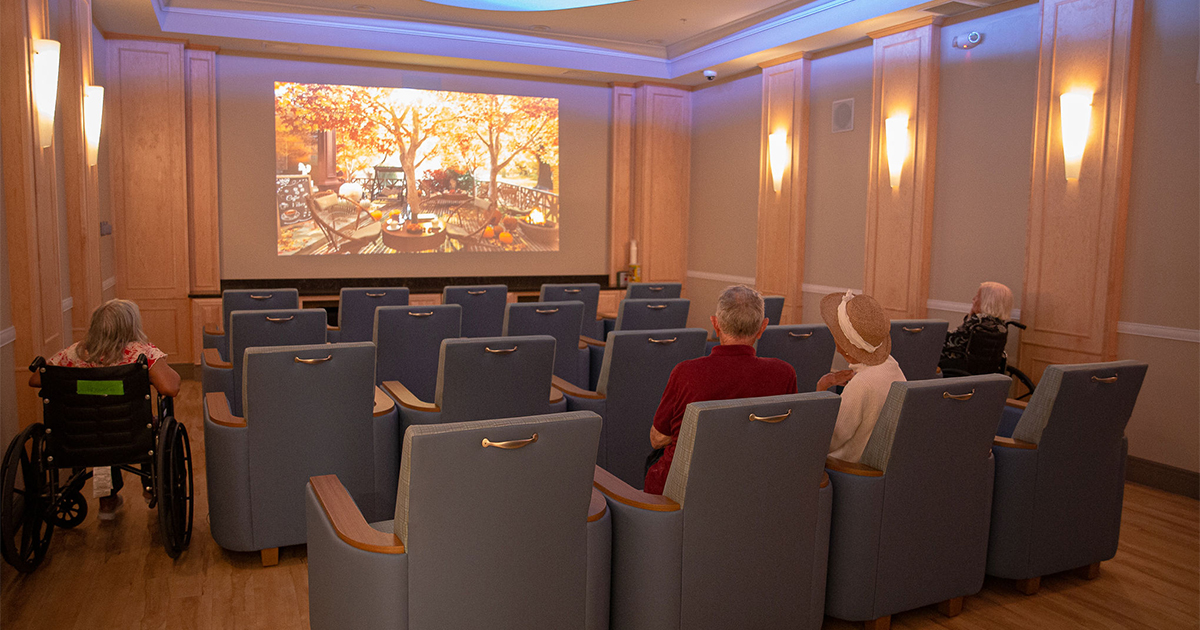Memory care has evolved significantly over the past decade, with a growing focus on person-centered care that honors the individual needs and experiences of those living with Alzheimer’s and other forms of dementia. Among the most innovative and effective tools being used in modern memory care communities are sensory rooms and sensory spaces — calming, interactive environments designed to gently stimulate the senses and enhance emotional well-being.
These spaces are more than just peaceful places to relax. Thoughtfully designed sensory rooms can reduce agitation, improve focus, and trigger positive memories— all of which can provide comfort for individuals with cognitive impairment.

What Are Sensory Rooms?
Sensory rooms, also known as multisensory environments (MSEs), are carefully curated spaces that engage one or more of the five senses—sight, sound, touch, smell, and even taste. These rooms often include soft lighting, gentle music or nature sounds, aromatherapy, tactile materials like textured fabrics or therapy putty, and visual elements such as bubble tubes, fiber optic lights, or calming images.
While they’re frequently used in schools and occupational therapy settings, sensory rooms have become a powerful part of memory care programming in assisted living and long-term care communities.
Why Sensory Stimulation Matters in Memory Care
For individuals living with dementia, sensory processing can be disrupted. As a result, they may become overwhelmed by their environment. Conversely, they can become under-stimulated, which can lead to boredom, anxiety, or restlessness. Sensory spaces help create a safe, soothing environment where residents can engage with their surroundings in a controlled and meaningful way.
These rooms are especially helpful for individuals who have difficulty communicating verbally. By providing sensory input, caregivers can offer a nonverbal way to connect, reduce distress, and even unlock memories that may seem out of reach.
Benefits of Sensory Rooms in Dementia Care
Reduced Agitation and Anxiety: One of the most common behavioral symptoms of dementia is agitation. Sensory rooms can act as a peaceful retreat when a resident is feeling overwhelmed, helping to reduce stress and promote relaxation through calming stimuli.
Improved Sleep Patterns: Sensory interventions, especially those involving soft music, dim lighting, and aromatherapy, can help regulate circadian rhythms and support better sleep, which is often disrupted in those with dementia.
Enhanced Mood and Emotional Expression: Sensory engagement can spark joy, laughter, or moments of calm. A familiar scent or song may trigger pleasant memories or emotions, improving mood and offering a sense of comfort and identity.
Stimulation of Memory and Cognitive Function: Multisensory experiences can tap into long-term memory and encourage cognitive engagement. Even small triggers, like the feel of a knitted blanket, can help evoke powerful connections.
Support for Personalized Care: Sensory activities can be tailored to each resident’s history, preferences, and stage of cognitive decline. A former gardener might enjoy soil textures or floral scents, while a retired teacher may respond positively to the feel of books or the sound of classical music.
Effective Sensory Room Design
The most successful sensory rooms are simple, uncluttered, and adapted to meet the needs of the specific residents who use them. Key features often include:
- Adjustable lighting (dim to bright)
- Soft, calming music or nature sounds
- Aromatherapy diffusers
- Tactile elements like soft blankets, sand trays, or textured tiles
- Comfortable seating and mobility-friendly layouts
- Interactive items like activity boards or sensory fidget tools
It’s also important for staff to be trained on how to guide residents through the space and observe their reactions. The goal is not to overstimulate, but to provide a calming, enriching environment.
Sensory rooms are a valuable, evidence-informed tool in memory care treatment. They offer a gentle, holistic approach to improving the quality of life for individuals living with dementia. At A Banyan Residence, we offer an innovative and beautiful multi-sensory room for our residents. Call us today to schedule a tour and experience it for yourself!







